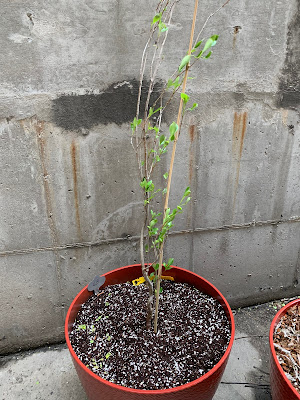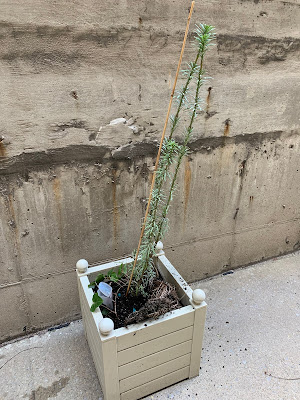Once upon a time, it was easy to keep track of what was in my garden. I had five or six pots, and each pot had, at most, four plants. Those days are gone.
Now I'm up to more than 30 pots, and the only way I can tell you what's supposed to be coming up this spring is by consulting a document I call my Garden Map. It's more of an inventory than a map, but it helps me remember what I've got, what it's called, when I got it, and where it came from. Each pot has a number, and the Garden Map is my cheat sheet for what's in the pot.
I thought we'd do "Who's Surviving, Who's Thriving, Who's Dead" in groups this year, and we'll begin with the group of pots nearest my back door.
Pot #1 is a galvanized metal planter I bought from Gardener's Supply in 2016. It contains a Japanese Pieris and three different colors of Astilbe plants. At least, if they ever bloom, they'll be three different colors. Right now they're just green.
The Japanese Pieris is blooming, which is a bit of a victory for me - since so few things bloom in my dark garden.
So I'll put that in the "Surviving" column. Why not "Thriving"? Well, here's a photo of some Japanese Pieris plants on the sidewalk in front of a local plant store - so you can see how they
really are supposed to bloom.
If mine looked like that, I'd call it "Thriving."
Of the three colors of astilbe (red, pink, and lavender), all are coming up, so let's call them "Surviving" too. But only the pink ones have ever bloomed, and we'll have to wait until June for that.
Pot #1A has three bare-root hostas that I bought this spring from a company called Michigan Bulb. "Bare root" just means you get a plant with no soil on the roots. You soak them when they arrive and then plant them. They're quite cheap - I paid $2.58 per plant for these, including shipping - but you get no hint as to what variety they are. They're all coming up, which is all one expects a hosta to do, so I'll put them in the "Thriving" column. (One is coming up much faster than its friends!)
Pot # 2 has two Blue Mouse Ears hostas, which have been thriving in my garden since 2016 and look like they're planning to do so again this year. The third plant is a Cherry Berry hosta, split from the one in Pot #3, and it looked terrible last season so I'm surprised it's coming up at all. So two "Thriving" and one "Surviving."
Pot #3 contains the Laceleaf Japanese Maple Orangeola, which I've had since 2017 and which is doing quite nicely. The leaves come in with a red tone and then turn green as they open up, as I hope you can see in the photo. Thriving.
Also in the pot, a Cherry Berry Hosta, which again, looked terrible last season but is coming up ("Surviving"), a Bergenia Pink Dragonfly which appears to be doing just fine ("Surviving," and if it blooms again, it'll get a "Thriving" score), and an Oxalis, which appears to be the only plant in this group of pots to receive a score of "Dead."
Pot #3A contains the brand-new maple tree that I showed you last week, plus a bare-root hosta from last year's batch of Walmart bare-root hostas, and a new hosta, the Lakeside Paisley Print.
I'm a little embarrassed about the Lakeside Paisley Print. Bluestone Perennials sent it to me after I complained that the Rhino Hide hosta they sent me looked dead. And then the Rhino Hide came to life. I tried to cancel the Lakeside Paisley Print at that point, but they had already sent it. So good customer service on their part, and I will continue to shop from them.
Pot #4 contains two heucheras, Happy Hour Lime and Obsidian, both from Bluestone Perennials in 2018. Both surviving and putting out new leaves, which improves my lifetime heuchera score considerably! And also another bare-root hosta from Michigan Bulb, which is just starting to come up.


































